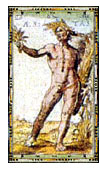 |
|
|
|||||||||||||||||||||||
 Atlas
Atlas
According to Greek legend, enormous and powerful creatures -- The Titans -- once inhabited the world. Uranus, the sky Titan, married Gaea, the earth, and produced a giant called Iapetus. Iapetus married Asia, who gave birth not only to the entire human race but an important figure in cartography: Atlas. Atlas was a troublemaker: He rebelled against Zeus and as punishment was given the task of keeping the sky from falling. Homer describes Atlas as “one who knows the depths of the whole sea, and keeps the tall pillars which hold heaven and earth asunder.” In Greek art, Atlas was depicted as holding the world on his shoulders; in architecture “atlantes,” muscular Atlas figures, hold up cornices and lintels. In North Africa, Atlas lived herding animals and raising little Titans of his own. When the hero Perseus asked for hospitality, he was turned away because an oracle had warned Atlas that a descendant of Zeus would cause his downfall. Withholding hospitality proved to be a mistake: Perseus carried with him the snake-haired head of Medusa, which turned anyone who saw it to stone. He showed the head to Atlas, who instantly became the Atlas Mountains, a craggy range nearly 4,200 meters high and 2,000 kilometers long that runs through Morocco, Algeria, and Tunisia. 
In 1585, Rumold Mercator prepared a book of maps drawn by his father Gerard. The idea of binding many maps in one volume was still quite new; maps had previously been stored as large sheets or scrolls, both cumbersome formats to use. To illustrate the concept of binding the world between covers, Rumold put a figure of Atlas on the title page, adding, “Atlas sive Cosmographicae meditationes de fabrica mundi et fabricate figura,” meaning, “Atlas, or cosmographical meditations upon the creation of the universe and the universe as created.” The result became known as an “atlas,” a word now used for any book of maps. Another mythological hero, Hercules, supposedly gave Atlas a rest by taking the world on his own shoulders. He had to trick Atlas into taking it back. Today, a Times atlas weighs only around five kilograms, which is still pretty heavy, but far less burdensome than the world itself. Copyright © 1999, 2000 media.org. |
||||||||||||||||||||||||
|